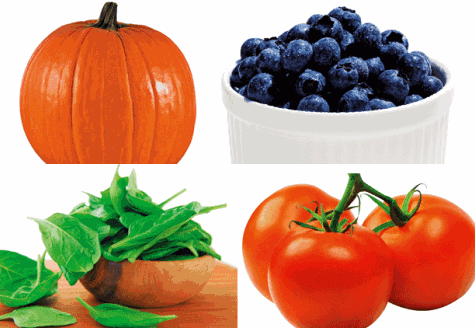Business & Finance Club - Diet : Studies have consistently shown that eating plenty of fruits and vegetables helps lower the risk of chronic diseases including stroke, heart attack, cancer, type 2 diabetes and high blood pressure. Their intake is also associated with eye health, improved memory and weight management.
While all fruits and vegetables get the nod for being low in calories and fat, and being a source of fibre, some deserve special attention for their exceptional nutrient content and ability to ward off illness and disease. Yet this is one food group where you won’t find standard labels listing calories, fat content and fibre to help guide your choices. So where does one begin when choosing what to buy in the produce aisle?
It turns out nature has devised its own labelling system for fruits and vegetables. Research shows that colourful fruits and vegetables do more than please the eye – their colour also gives an indication of the nutrients they contain. In fact, some of the most nutrient-rich fruits and vegetables are also the most colourful. That’s because many pigments that give fruits and vegetables their distinct colour double as powerful antioxidants that help protect health. Follow these colour-based guidelines to boost your nutrient intake.
Orange
Beta-carotene is responsible for the bright orange and yellow colour of many fruits and vegetables, including carrots, sweet potatoes and winter squash. Beta-carotene, which belongs to the carotenoid family of pigments, plays a starring role in the production of vitamin A, a fat-soluble vitamin needed for bone growth, eye health and immune function.
What's more, this colourful pigment is also a potent antioxidant. Its intake has been linked with a protective effect against some types of cancer, including cervical, lung and skin cancer.
When it comes to stocking up on beta-carotene - let your eyes do the searching - the deeper the orange colour of the fruit or vegetable, the more beta-carotene it contains. Sweet potatoes, carrots and pumpkin top the list of the best food sources of beta-carotene. Keep in mind that lightly steaming foods such as carrots or spinach can increase the amount of beta-carotene available; prolonged cooking can have the opposite effect.
Green
Dark green leafy vegetables get their brilliant colour from lutein and zeaxanthin, phytochemicals that also belong to the carotenoid family. While lutein and zeaxanthin actually have a yellow hue, they are found in abundance in green leafy vegetables, such as spinach, rocket, kale, collard greens and romaine lettuce. These phytochemicals are important for eye health as they protect the lens and retina of the eye against both age-related macular degeneration and cataracts.
However, they are just the tip of the iceberg when it comes to nutrients found in green leafy veg. This group of vegetables is also an excellent source of vitamins A, C and K, potassium, iron and folate. Research has shown that a high intake of green leafy vegetables can offer protection from lung, gastric and ovarian cancer, as well as heart attacks and stroke.
When choosing, keep in mind the darker the shade of green, the more nutrients it contains. Some leafy veg that you should check out include beet greens, Swiss chard and rapini.
Red
Lycopene, the same compound that gives tomatoes, watermelon, pink grapefruit and guava their bright pinkish-red hue is also responsible for many of their health benefits. Lycopene also acts as a potent antioxidant in the body.
Research has shown that high intakes of lycopene can protect against pancreatic cancer, as well as colon and prostate cancer. One study of nearly 40,000 women also found that high intakes of the antioxidant was linked to a lower risk of heart attack and stroke.
Tomatoes and tomato products lead the pack as the best source of lycopene in the diet. Unlike most other nutrients, heat actually boosts the amount of lycopene the body can absorb - that's why cooked tomatoes, and heat-processed tomato products, such as canned tomatoes and tomato sauce, contain the most lycopene.
Other noteworthy red fruits and vegetables that deserve a spot on your plate include red cabbage, cranberries and pomegranates.
Blue and Purple
Berries have always garnered attention,and for good reason. Not only are theylow in calories and high in fibre and vitamin C, they're packed with anthocyanins - the pigment that gives them their rich reddish-blue colour.
Aside from providing berries with their vibrant colour, anthocyanins act as powerful antioxidants in the body. Lab studies show anthocyanins may be effective at protecting against some types of cancer, ageing, inflammation and bacterial infections. A study published last year in the American Journal of Clinical Nutrition shed light on its heart health benefits as well, after it was discovered that people who took a daily supplement of the pigment experienced an increase in HDL (healthy) cholesterol, and a drop in LDL (unhealthy) cholesterol levels after just twelve weeks.
Thanks to their intense colour, blueberries and cranberries have the highest anthocyanin content. Since fresh berries can be hard to come by here, frozen berries are a great option. Boost your berry intake by adding these little gems to pancake batter, homemade smoothies and swapping them for croutons on a salad.
Studies have consistently shown that eating plenty of fruits and vegetables helps lower the risk of chronic diseases including stroke, heart attack, cancer, type 2 diabetes and high blood pressure. Their intake is also associated with eye health, improved memory and weight management.
While all fruits and vegetables get the nod for being low in calories and fat, and being a source of fibre, some deserve special attention for their exceptional nutrient content and ability to ward off illness and disease. Yet this is one food group where you won't find standard labels listing calories, fat content and fibre to help guide your choices. So where does one begin when choosing what to buy in the produce aisle?
It turns out nature has devised its own labelling system for fruits and vegetables. Research shows that colourful fruits and vegetables do more than please the eye - their colour also gives an indication of the nutrients they contain. In fact, some of the most nutrient-rich fruits and vegetables are also the most colourful. That's because many pigments that give fruits and vegetables their distinct colour double as powerful antioxidants that help protect health. Follow these colour-based guidelines to boost your nutrient intake.
How much do you need?
The recommended daily consumption of fruit and veg varies between five and seven servings. One serving equals:
- 80g of fruit
- 30g of green leafy vegetables
- 50-70g of chopped vegetables such as carrots, green beans or broccoli
Here are some easy ways to meet your daily requirement:
- Top up your morning cereal with a handful of fresh berries, or add them to pancake batter, smoothies, and as salad croutons.
- Add a diced apple to a bowl of low-fat yoghurt as a snack.
- Swap iceberg lettuce for spinach or rocket.










